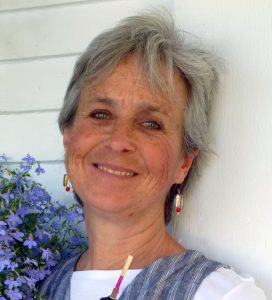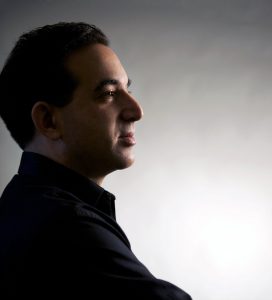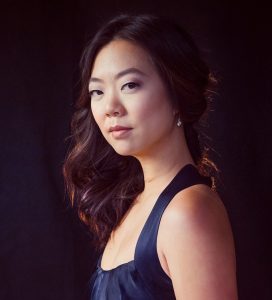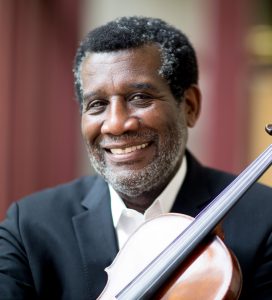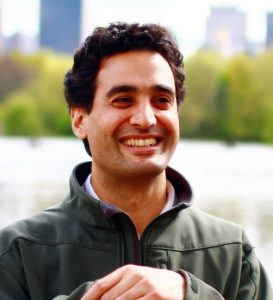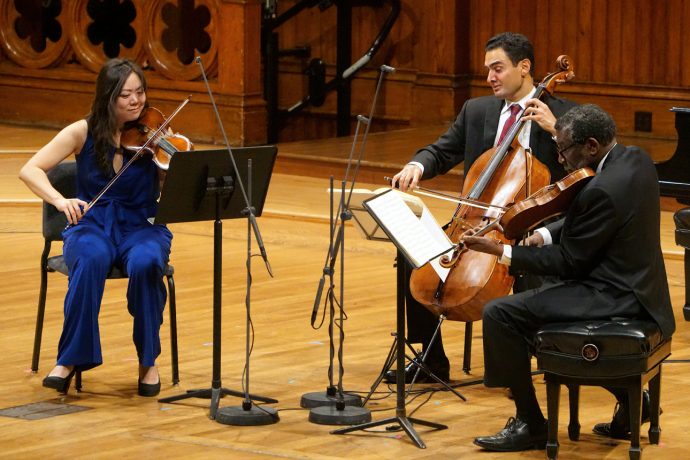Ludwig van BEETHOVEN String Trio in D major, Op. 9, No. 2 (1798)
Alyssa Wang, violin; Marcus Thompson, viola; Raman Ramakrishnan, cello
Peter Child Four Movements after Kandinsky for Oboe, Viola, and Piano (2024 BCMS commission)
Peggy Pearson, oboe; Marcus Thompson, viola; Max Levinson, piano
Felix MENDELSSOHN Piano Trio in D minor, Op. 49 (1839)
Alyssa Wang, violin; Raman Ramakrishnan, cello; Max Levinson, piano
Featured musicians
Beethoven’s String Trio in D major opens slowly with a warm, lush sound before the violin takes the lead, guiding the ensemble towards an energetic second theme. Following a stately minor mode Andante, the violin shines again with quick flourishes of notes in the Minuet, while the cello introduces the lively theme of the Rondo finale.
Four Movements after Kandinsky by acclaimed Boston composer Peter Child, who the Boston Musical Intelligencer has praised as “one of the most interesting and heartily youthful composers anywhere in America today,” was inspired by Kandinsky’s earlier works, “their vividness of color and line, the power of their symbolism.”
Proclaimed by Schumann to be the “master trio of the age,” Mendelssohn’s Piano Trio No. 1 in D minor simmers with passionate emotions masterfully contained in classical forms. Tumult and agitation reign through much of the work, delivered with sparkling virtuosity by each player. Respite comes in the tender second movement, a “song without words.”
Full Program notes
Ludwig van Beethoven
(Bapt. December 17, 1770–March 26, 1827)
Calling them “la meillure de [mes] oeuvres” (the best of my works), Beethoven took great pride in his Op. 9 set of three string trios, which many see as the proving-ground for much of what materializes in the Op. 18 string quartets begun later that same year. One of several opuses dedicated to Count Browne-Camus—an important early patron of Beethoven in Vienna—the trios signal Beethoven’s transition toward his more mature “heroic” period.
This second trio of the Op. 9 set opens with a standard sonata form movement that captures some of the exuberance of Beethoven’s early years in Vienna. The contrapuntal texture and active commentary from the cello demonstrate an awareness of dialogue between the voices so amplified in the quartets of Haydn, with whom Beethoven had briefly studied.
By contrast, the D minor Andante quasi allegretto pairs halting and striking gestures with cantabile solo melodies against pizzicato and arpeggiated lines. Beethoven varies the reprise of the material, conveying, as one reviewer has put it, “the shadows of D minor within the ‘swing’ implied by the time signature of 6/8.”
The buoyant third movement Menuetto takes its cue from the nature of the first movement, maintaining a more scherzo-like character. The trio features playful staccato motion in classically balanced four-bar phrases, providing more of a contrast in articulation and affect than harmony.
The piece closes with a rondo theme that captures the folkish flavor so common to rondos at the time, while carrying forward the playfulness of the trio from the preceding movement. Here Beethoven exploits register and texture while alternating between homophonic and imitative sections, undergirding displays of virtuosity from all three instruments with a consistent lightheartedness.
Peter Child
(Born May 1953)
Peter Child’s long tenure at MIT was celebrated last March with a concert of his works presented by Collage New Music, including A Golden Apple: Six Songs of Intimacy and Loss (2023), a setting for soprano and piano of six contemporary women poets; as well as Stella celi (2021), written for cello and calling upon plainchant hymn first recorded in fifteenth-century manuscripts. Also on that concert was Child’s Six Dances of Death (2020), which draws inspiration from a series of woodcuts by sixteenth-century painter and printmaker Hans Holbein the Younger. Child’s oeuvre spans almost every concert genre with themes that range from humanitarian crises to personal experiences of loss, and pulls inspiration from a mélange of sources. Born in England, Child moved to the US through a junior-exchange program at Reed College in Oregon, and received his PhD in Composition from Brandeis, joining the MIT faculty in 1986. He has composed for many prominent music ensembles in the Boston area, including Boston Modern Orchestra Project, Cantata Singers, Emmanuel Music, the NEC Contemporary Ensemble, and the Lydian Quartet. Internationally, he has performed and collaborated with his wife, Norwegian artist Lina Viste Grønli, on works such as Tell Everyone: Fragments of Sappho, which was commissioned for the 2021 Bergen International Festival for the opening of Grønli’s permanent public art installation, Benkene til Kim. Child is presently Class of 1949 Professor of Music Emeritus and Margaret MacVicar Fellow at MIT. He has this to say about the new work:
“In the summer of 2024, shortly after I had embarked upon my new trio for the Boston Chamber Music Society, I experienced an exhibition of Kandinsky’s early works at the National Museum, Oslo. The effect was electric. The beauty of the works, many of them woodcuts (‘xylographs’), their vividness of color and line, the power of their symbolism, not necessarily obvious but compelling nonetheless, the daring ways in which figurative imagery dissolves into rough-edged compositions of line, mass, and color, anticipating abstraction—these things really took hold of me. Parallels with the musical experiments of Kandinsky’s contemporary and close associate Arnold Schoenberg were impossible to miss. My timely encounter with the early work of Kandinsky shaped the form and ideas in my trio, which came to be called Four Movements after Kandinsky:
I. “Flame” (Flamme) is the title page of the series Xylographies, 1907. A still, meditative woman in traditional costume stands disquietingly adjacent to a mounted rider, the horse rearing precipitously on its hind legs. In the first movement, music alternates, phrase by phrase, between states of motion and stillness, urgency and calm, action and contemplation.
II. “Two Riders before Red” (Zwei Reiter var Rot), from Kandinsky’s seminal book, Klänge (Sounds), 1913. One rider hurtles forward and the other rears, against a background of intense red (a sunset?) and windswept trees. In movement II instruments chase each other contrapuntally at great speed. The discipline of a fugue is almost torn apart by its reckless, galloping episodes.
III. “Oboe.” Kandinsky included poetic text alongside visual imagery in Klänge, including this excerpt: “Nepomuk leaned his back against the trunk of the little white green birch tree, pulled out his big long black oboe and played many beautiful songs that everybody knows. He played for a long time with deep feeling.”
IV. “Great Resurrection” (Grosse Auferstehung), from Klänge: What seems at first a vortex of abstract color and line resolves, as we take it in, into apocalyptic images—a sounding horn, a headless figure, a cowering crowd, in the distance the ubiquitous rider and rearing horse, and more. Music hurtles to its climax at the midpoint of movement IV, a turning point, where turbulence and storm gradually give way to lyrical tranquility, closure, and transcendence.
I am very grateful to the Boston Chamber Music Society for the commission that brought this music into being.”
Felix Mendelssohn
(February 3, 1809–November 4, 1847)
The earliest version of this piano trio was completed in July 1839, but Mendelssohn made substantial revisions—most notably to the piano part of the last movement—after the work’s premiere. At this point in his career, Mendelssohn was in high demand as a conductor in Germany and England, but did not falter in his compositional activities, completing the Op. 44 String Quartets, the Ruy Blas Overture, Op. 95, and his Symphony No. 2 (‘Lobgesang’) all in the years 1839 to 1840.
The sonata form Molto allegro ed agitato offers the main theme in the cello, with the piano firmly establishing D minor, only to have the first violin then expand the theme outward. Pianistic flourishes transition the movement to the contrasting cantabile second theme in A major, once again introduced by the cello. Mendelssohn keeps the virtuosity in check to make space for a more lyrical spirit. The recapitulation revives the main theme in D minor, but this time with an ethereal pedal tone and countermelody in the first violin. A descending ritardando cascade from the piano seems to pull the brake, giving all three voices a chance to collect themselves. There is a final unison reference to the main theme, heard in the violin and cello, in the closing assai animato section that plants its feet resolutely in D minor.
The second movement Andante con moto tranquillo is a stunning example of Mendelssohn’s gifts for writing Lieder ohne Worte (songs without words) with the tuneful melody first brought out in the right hand of the piano. When the cello and violin enter, one hears sweet angelic three-voice chorales of the type that Mendelssohn would include in his oratorio Elijah seven years later. The minor section offers a more melancholy pathos with descending gestures, but the composer balances it with a less vocally-influenced texture, including pizzicato in the cello and running sixteenths in the piano. The first violin hands off the sixteenth notes to the cello in one fluid line that melts into a gentle rocking motion to support one last thematic reference in the piano before ending quietly in B-flat major.
The sparkling Scherzo leggiero e vivace offers more of an interlude than a traditional movement. Cast in a dense sonata form, a concentrated rhythmic motif upstages the thematic construction. The energy is relentless but buoyant, condensing some of the spirit from the first movement and providing a worthy contrast to the Andante.
While he moves to a 4/4 in D minor, Mendelssohn harnesses the momentum from the scherzo into the Allegro assai appassionato Finale. Less whimsical than the Scherzo, the movement is full of rambunctious passion in contrast with a cantabile melody started in the cello and taken up by the violin. This provides a good parallel balance with the first movement and evokes a Schubertian approach to thematic contrast. The refined virtuosity reflects much of the revisions he made after the premiere, and the triumphant con forza coda ends the work in the major key.
© 2024 Rebecca G. Marchand
From the collection of the Museum of Modern Art, New York
Movement 1: Flame
Movement 2: Two Riders Before Red
Movement 3: Oboe
Movement 4: Great Resurrection

